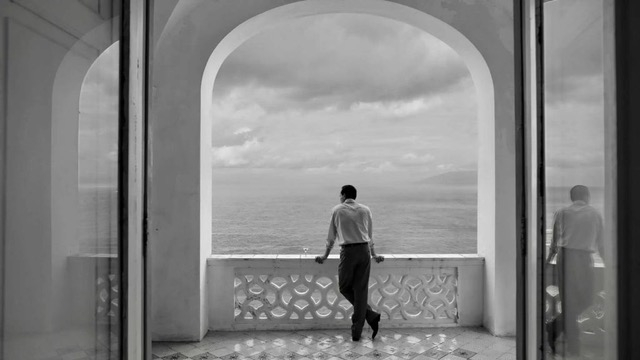
RE-MAKE / RE-MODEL: Ripley--well, uh, um, you're, gee, Steven Zaillian's noir-ish 8-part black and white TV adaptation of Patricia Highsmith's 1955 novel The Talented Mr. Ripley novel was pretty much tolerable in certain aspects (cinematography mainly), but honestly, imho, not a patch dramatically overall on either previous big-screen versions Plein Soleil (1960, d. Rene Clement) and/or the eponymous 1999 version directed by Anthony Minghella. "Somnolent" was the word used by the NY Times reviewer in describing this chilly, muted exercise in existential monochrome stretched over eight chapters, which succeeded in bleeding all the color and jeu d'esprit out of the original book and the two cinematic versions—the word "lugubrious" also comes to mind also and would not be far afield in describe the cumulative effect of the series also. It's like being bludgeoned in slow motion by a hammer made of soggy marshmallows.
Both the original music and the selected needle drops on the soundtrack were effective in parts, especially the recurring usage of songs by legendary Italian jazz vocalist Mina Mazzini (in fact, the cover of one of Mina's 50 albums was used as a period prop and flashed onscreen a few times)—but Episode 7 ended inexplicably with Tom Ripley's triumphant entrance into the Venetian Lagoon accompanied by THIS iconic piece of music by Shostakovich, inextricably bound up with the credits fore and aft of Stanley Kubrick's Eyes Wide Shut:
So why use it again? I mean, what was the logic in that?? What were Zaillian and his music tipsters thinking by recycling it—what memory, if any, were they trying to jog here? All it triggered in me was astonishment and a feeling of disgust at the chutzpah of re-contextualizing this beautiful composition (already attached to an iconic film) to no discernible end. As this Johnny One-Note of a series—as bloated throughout all eight episodes as the water-logged corpse of Dickie Greenleaf—bore about as much relation to Eyes Wide Shut (or any other Kubrick film) as the Man in the Moon.
(There were also some musical bits on the soundtrack played on celeste towards the end of the series designed—I guess—as a kind of throwback/homage to the creepy celeste-driven music that accompanied Matt Damon's predations in the 1999 film. It was designed, no doubt, to make one think back on the—unfortunately—superior cinematic version in the process of trying to bolster the cred of this mini-series. "Hey folks, recall this music from the Matt Damon version?" When in doubt, recycle!).
Wouldn't you know that the Minghella version was being programmed on another streaming cable channel almost immediately after Caroline Sinclair and I finished watching this series on Netflix? The contrast between the two radically different takes on basically the same story was breathtaking.
The Italian landscape is the real star of both versions.
